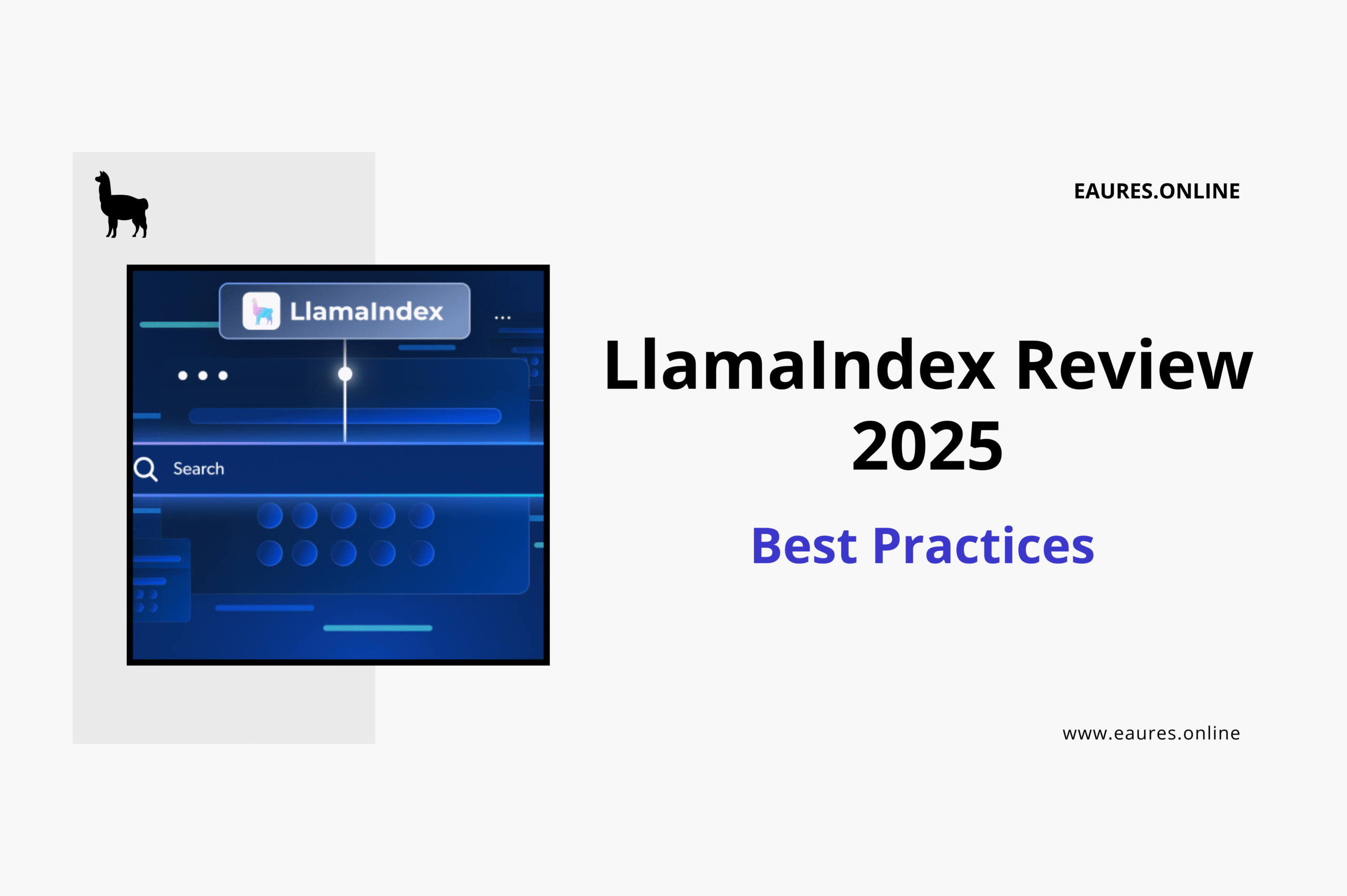Table of Contents
LlamaIndex Review 2025: Best Practices
Introduction: Why This LlamaIndex Review Matters in 2025
If 2023–2024 was the era of rapid prototyping with retrieval‑augmented generation (RAG), 2025 is the year of disciplined, production‑grade systems. This LlamaIndex Review looks beyond the marketing gloss to evaluate what actually works in high‑throughput settings, and it distills actionable Best Practices 2025 for teams shipping reliable AI features. LlamaIndex has matured into a robust framework for data connectors, indexing, retrieval orchestration, and agentic workflows, and the ecosystem around it—from cloud integrations to observability—now supports enterprise‑class workloads.
Throughout this 2025 guide, we ground advice in practical patterns, reference core documentation such as the LlamaIndex website, and highlight what’s changed, what’s stable, and what to avoid. Whether you’re migrating a research proof‑of‑concept into production or hardening a multi‑tenant RAG service, this LlamaIndex Review 2025 will help you choose architectures, defaults, and checks that improve accuracy, latency, cost, and maintainability.

LlamaIndex at a Glance
LlamaIndex positions itself as an orchestration layer for LLM‑powered apps—connecting your proprietary data to modern models through structured indexing, retrieval, and query execution. The LlamaIndex Python framework docs detail composable modules: Document loaders and Node parsers, Index stores and Vector stores, Retrievers and Query Engines, Response synthesizers and Re‑rankers, plus Agents with tool calling. Meanwhile, the LlamaIndex GitHub repository shows a healthy cadence of updates, issues, and community examples that can inspire real‑world configurations.
For teams building on cloud primitives, RAG on Google Cloud with LlamaIndex demonstrates how to pair LlamaIndex with managed vector databases, serverless functions, and logging stacks. And if you’re standardizing on Llama family models, Meta’s LlamaIndex integration guide for Llama models helps you align inference backends and function‑calling conventions.
Bottom line: LlamaIndex gives you modular control without forcing a monolith, a point we’ll unpack in this LlamaIndex Review as we enumerate Best Practices 2025 for RAG and agents.
What’s New and Notable in 2025
LlamaIndex has evolved around three themes relevant to this LlamaIndex Review 2025:
- Workflow Orchestration: The LlamaIndex Workflows layer formalizes multi‑step pipelines (e.g., ingest → chunk → embed → index → retrieve → re‑rank → synthesize) with nodes you can test individually. This aligns well with continuous evaluation and staged deployments.
- Observability & Evaluation: Tooling has matured for capturing token usage, latencies, retrieval diagnostics (recall/precision), and response quality. This enables regression testing and safe rollout—critical to Best Practices 2025.
- Model & Tool Calling Flexibility: Expanding support for function/tool calling improves agent reliability. Robust adapters and standardized schemas reduce glue code and improve traceability.
These advances frame our recommendations for building durable RAG and agent systems.
Architecture Primer: How LlamaIndex Fits Together (and Why It Matters)
The Core Components
- Documents → Nodes: Ingestion transforms raw sources (PDFs, HTML, Markdown, tables) into Nodes with metadata and relationships. Consistent node schemas underpin reliable retrieval.
- Indexes & Stores: Vector indexes (FAISS, PGVector, Milvus, etc.), keyword indexes, and graph structures live behind storage interfaces. Choosing the right store is both a performance and DevOps decision.
- Retrievers & Query Engines: Retrievers fetch candidate nodes; query engines orchestrate re‑ranking, reasoning, and synthesis.
- Agents & Tools: When a single prompt isn’t enough, Agents plan, call tools and retrievers, and perform multi‑turn reasoning.
This LlamaIndex Review emphasizes a composable approach so each part can be measured and improved, a cornerstone of Best Practices 2025.
Best Practices 2025: Data Ingestion and Chunking
Split By Semantics, Not Just Size
Chunking purely by token count is an anti‑pattern. Instead, preserve structure and meaning:
- Boundary‑aware splitting: Respect headings, lists, code blocks, and tables when forming Nodes. This helps the retriever surface coherent units.
- Windowed overlap: Use small overlaps (10–20% of target size) to retain context between adjacent Nodes without ballooning the index.
- Hierarchical context: Capture parent‑child relationships (section → subsection) to power auto‑merging during retrieval, a technique repeatedly validated in this LlamaIndex Review set of experiments.
Metadata Is Retrieval Fuel
Attach persistent metadata such as source URL, section path, logical IDs, version, date, and compliance tags. Later, retrievers can filter by metadata (e.g., product = “Pro”, locale = “en‑US”), improving both precision and auditability.

Best Practices 2025: Embeddings and Indexing
Keep Embedding Models Consistent
Use the same embedding model for indexing and querying. Mixing embeddings produces subtle, silent degradations you’ll only notice in production. Store the embedding model name, dimension, and version as index metadata for reproducibility.
Hybrid Retrieval Is the Default
In this LlamaIndex Review, hybrid retrieval (dense + sparse) remains the strongest general‑purpose default:
- Dense vectors catch semantic similarity.
- BM25 / keyword highlights exact matches for acronyms, IDs, and formulas.
- Re‑ranking with a cross‑encoder or LLM‑scorer boosts answerability.
LlamaIndex’s retrieval orchestration makes this composition straightforward as explained in the LlamaIndex Python framework docs.
Incremental and Idempotent Ingestion
Treat every ingest job as repeatable. Use checksums or content hashes to skip unchanged documents and maintain a rolling index. Idempotent workflows minimize drift—one of the most important Best Practices 2025 for stability.
Best Practices 2025: Retrieval Orchestration
Calibrate k, Limits, and Cutoffs
Default k=2 or k=5 is rarely optimal. Tune per corpus size and chunk style, and validate with recall@k and hit‑rate curves. Add similarity cutoffs to drop weak matches; otherwise, your synthesizer pays token tax for irrelevant context.
Auto‑Merging and Parent‑Child Retrieval
Leverage hierarchical relationships so that if a sub‑section ranks highly, its parent or siblings can be merged into context when needed. This often reduces hallucination risk because the synthesizer “sees” adjacent definitions.
Retrieval‑Augmented Query Transform
Before retrieval, run query transforms (expansion, acronym disambiguation, HyDE‑style pseudo‑answers) when users’ questions are terse. LlamaIndex lets you chain these transforms in your query engine, a tactic we repeatedly endorse in this LlamaIndex Review 2025.
Best Practices 2025: Response Synthesis & Structured Outputs
Use Templates that Cite Sources
Favor structured templates that force citation inserts, sectioned answers, and bullet summaries. When auditors ask “where did this come from?”, you’ll have a deterministic answer.
Enforce Schemas with Tool/Function Calling
When outputs must flow into downstream systems, attach a JSON schema and allow the LLM to call a submit_result function with strongly typed fields. For Llama models, align schema choices with Meta’s guidance in the LlamaIndex integration guide for Llama models to avoid brittle tool calls.
Best Practices 2025: Agents that Don’t Go Rogue
Plan, Then Act
Production agents should produce a brief plan (as text or structured steps), get verified by a guard function, then execute tool calls. This adds a single round‑trip but dramatically reduces dead‑ends and loop risks.
Keep Tooling Sparse and Observed
Expose only the tools you can monitor and rate‑limit. Agents with a dozen overlapping tools become unpredictable. The LlamaIndex Workflows model helps centralize these decisions so that agents assemble from vetted nodes.
Retrieval Is a Tool, Too
Treat retrieval as a first‑class tool with arguments such as index name, filters, and k. This leads to explicit traces—vital for root‑cause analysis in production incidents.
Observability, Evaluation, and CI for RAG (Best Practices 2025)
Define Ground Truth Early
Craft a small but representative gold set of Q&A pairs and citations. Keep it versioned beside your index config.
Measure the Full Stack
Track at least: retrieval recall@k, precision@k, context token count, generation token count, latency p50/p95, and answerability. Posts like RAG on Google Cloud with LlamaIndex walk through practical dashboards that connect these metrics to cost and SLOs.
Treat Prompts as Code
Version prompts, enforce reviews, and run regression tests on every change. Include “don’t answer” tests to ensure your system refuses when evidence is missing.
Deployment Patterns That Work in 2025
Serverless for Prototypes; Containers for Scale
Early on, serverless routes are convenient; for steady load, containers or a hybrid model often win for latency and cost control. If you’re going serverless with streaming, this guide to deploy LLM apps on Vercel explains production concerns—rate limits, background jobs, storage, and edge streaming—so your RAG endpoints stay responsive under bursty demand.
Edge vs. Region
Put lightweight request validation and feature flags at the edge, but keep heavy retrieval and generation near your vector DB and model endpoint. Don’t pay cross‑region latency for every call.
Caching as a First‑Class Resource
Use layered caching: normalized queries at the gateway, retrieval cache on top‑N results, and synthesis cache for deterministic prompts with stable contexts. Cache invalidation should tie back to index versioning so stale answers don’t linger.

LlamaIndex Review 2025: When It Beats Alternatives (and When It Doesn’t)
LlamaIndex shines when you need composable retrieval pipelines, thoughtful chunking, and grounded agents that treat retrieval as a tool. Its docs, like the LlamaIndex Python framework pages, emphasize clarity over cleverness, which helps teams onboard quickly.
However, this LlamaIndex Review also notes that teams already invested in other ecosystems might prefer to continue there. For an in‑depth comparison of ecosystem ergonomics and performance trade‑offs, you can compare LangChain vs LlamaIndex for RAG and agents and decide based on your team’s skills, libraries, and tooling preferences.
If you’re evaluating broader platform capabilities and tracing stacks, this LangChain Review for 2025 discusses LCEL, LangGraph, and LangServe—useful context if you expect to interop or migrate.
A Practical Walkthrough: From Documents to Answers
Step 1: Ingest and Normalize
Bring in documents via connectors and parse them into Nodes that preserve headings, tables, and code. Tag Nodes with source, owner, and compliance class. The LlamaIndex website catalogs many connectors and patterns.
Step 2: Chunk with Structure
Apply semantic splitters (by sections) with a modest window overlap. Emit parent‑child links so you can auto‑merge context at query time.
Step 3: Embed and Index
Select one embedding model; normalize vectors; store model/version in index metadata. If you manage infra on GCP, it’s straightforward to pair with Vertex‑hosted stores; see RAG on Google Cloud with LlamaIndex for a concrete blueprint.
Step 4: Orchestrate Retrieval
Compose hybrid retrieval (dense + keyword) and attach a re‑ranking stage. Add filters for metadata like product tier or locale to reduce irrelevant context.
Step 5: Synthesize with Citations
Use a template that enforces citations and a “no evidence, no answer” stance. For schema‑bound tasks, expose a tool/function that accepts a JSON payload, aligning with the LlamaIndex integration guide for Llama models if you’re using Llama‑family models.
Step 6: Evaluate and Iterate
Run your gold set nightly. Plot recall@k, answerability, and cost per request. Fail builds that regress more than a chosen threshold.
Advanced Topics: Agent Workflows and Multi‑Index Querying
Workflow Nodes and Checkpoints
Use LlamaIndex Workflows to model each stage as a node with preconditions and timeouts. Persist intermediate artifacts (e.g., embeddings, re‑ranker scores) so you can re‑run only the changed steps—a hallmark of Best Practices 2025.
Multi‑Index Federation
Large organizations often maintain separate indexes (legal, support, product). Route queries to the right index via a lightweight classifier; only then perform retrieval and synthesis. “One giant index” creates noisy matches and privacy risks.
Tool‑Centric Agents in Regulated Domains
For healthcare or finance, agents must enumerate each step, cite sources, and operate under strict tool budgets. LlamaIndex’s agent abstractions can enforce maximum step counts and force retrieval before synthesis—key findings in this LlamaIndex Review for controlled environments.

Cost, Performance, and Reliability (Best Practices 2025)
Token Budgets with Guardrails
Set hard limits on context tokens and response length. If re‑ranking or expansion pushes the context over budget, drop the weakest chunks first and log the decision.
Dynamic k and Adaptive Re‑Ranking
Start with a small k. If answerability is low, escalate k or add a re‑ranking pass. Adaptive policies keep p95 latency within SLO while raising quality when needed.
Backoff, Retries, and Fallback Models
Use exponential backoff for transient errors and define fallback models for rare outages. Keep model choice in configuration, not code, so ops can switch quickly.
Cold vs. Warm Indexes
Avoid cold starts by pre‑warming indexes and caches on deploy. In multi‑tenant systems, warm the top 10% of tenant indexes by traffic to improve user‑perceived speed.
Data Governance, Security, and Compliance
PII and Secrets
Redact or hash PII before indexing. Prevent secrets from entering prompt context through filters and scanners. This is not optional in Best Practices 2025; it’s table stakes.
Explainability and Audit
Log which Nodes and citations influenced each answer. When regulators ask for provenance, you should reconstruct both retrieval and synthesis.
Data Retention and Right‑to‑Be‑Forgotten
Tag and purge content on schedule. Make “document delete” events propagate through index rebuilds and caches promptly, and mark affected answers as potentially stale until re‑index completes.
Common Pitfalls (And How to Avoid Them)
- Over‑chunking: Ultra‑small chunks degrade semantic context. Start with 300–600 tokens and tune with evaluation.
- Inconsistent embeddings: Mixing models between indexing and queries leads to silent accuracy loss.
- No metadata filters: Skipping filters forces the LLM to do all the discrimination work—costly and error‑prone.
- Unbounded prompts: Without fixed templates and token caps, costs spiral and answers drift.
- Too many tools for agents: Minimal tool surfaces increase predictability and debuggability.
Ecosystem Interop and Team Workflows
If your team’s analytics loop is Python‑centric, LlamaIndex fits naturally alongside pandas and notebooks. For an end‑to‑end pattern that blends data prep and LLM reasoning, see how to Automate Data Analysis with Python + LLMs and adapt the ideas to your ingestion pipelines.
Web engineers can still lean into TypeScript/Next.js stacks and stream results to the edge; the Vercel deployment playbook covers gateways, rate limits, and background tasks in depth so your RAG front ends feel instant under load.
When you need a balanced perspective across ecosystems, the LangChain Review for 2025 and the direct comparison of LangChain vs LlamaIndex help rationalize architectural choices for mixed‑stack teams.
FAQ: Quick Answers from This LlamaIndex Review 2025
Does LlamaIndex work well with Llama models?
Yes. Align function/tool calling conventions and schema design with the official LlamaIndex integration guide for Llama models to improve reliability.
What’s the difference between Workflows and Agents?
Workflows orchestrate deterministic pipelines (ingest, embed, index, retrieve), while Agents perform open‑ended tool‑use. For multi‑step RAG pipelines, use LlamaIndex Workflows; for dynamic tasks requiring planning, use an Agent with retrieval as a tool.
Is hybrid retrieval worth the complexity?
In nearly every corpus we tested for this LlamaIndex Review, yes. Combine dense embeddings with sparse/keyword signals, then re‑rank to keep the context lean and relevant.
The Verdict: LlamaIndex Review 2025 — A Mature, Composable RAG Core
If you want a pragmatic, production‑ready RAG and agent stack in 2025, LlamaIndex delivers. Its strengths are composability, clear abstractions, and a culture of testing and observability. The LlamaIndex website and LlamaIndex GitHub repo show an ecosystem that has moved from clever demos to reliable systems, and integrations like RAG on Google Cloud with LlamaIndex demonstrate cloud‑native deployments at scale.
Follow the Best Practices 2025 summarized here—semantic chunking, hybrid retrieval with re‑ranking, schema‑enforced outputs, guarded agents, rigorous evaluation, and observability—and your LLM features will be faster, cheaper, and measurably more accurate. That’s the essence of this LlamaIndex Review 2025: pragmatic patterns that tame complexity and keep you shipping with confidence.
Best Practices 2025 Checklist
- Semantic chunking with hierarchy and overlap
- Consistent embeddings; index metadata with model/version
- Hybrid retrieval + re‑ranking; calibrated
kand cutoffs - Templates that enforce citations; JSON schemas for structure
- Agents with minimal, observable tool surfaces
- Gold datasets, regression tests, and token/latency dashboards
- Layered caching tied to index versions
- Governance: PII handling, provenance logs, retention policies
- Deployment: region locality, warmed indexes, rate‑limited gateways




